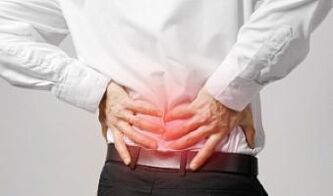Pain in the spine when moving or even at rest, this has probably happened to almost every adult.Such unpleasant sensations can be caused by many factors, ranging from chronic eating disorders to serious diseases.But one of the most common causes of pain in the spine is osteochondrosis.
even at rest, this has probably happened to almost every adult.Such unpleasant sensations can be caused by many factors, ranging from chronic eating disorders to serious diseases.But one of the most common causes of pain in the spine is osteochondrosis.
Osteochondrosis is a complex pathology that is primarily associated with impaired nutrition of the bone and cartilage structures of the spine.The consequence of this is a gradual flattening of the intervertebral disc, a deterioration of its shock-absorbing properties, as well as a weakening of the musculo-ligamentous apparatus that supports the spine.
Today, scientists believe, oddly enough, that the main cause of spinal osteochondrosis is an evolutionary factor.This is a kind of "payback for walking upright".After all, with a vertical position of the body, the load on the spine will be maximum.The situation can worsen and accelerate the development of the pathology:
- work involving frequent bending, turning and sudden movements;
- constant sitting in an incorrect position;
- Frequent lifting and carrying of heavy loads;
- intense participation in certain sports.
What are the types of osteochondrosis?
There are several variants of this disease, which are classified depending on which part of the spine the disorders occur in:
- cervical osteochondrosis;
- chest;
- lumbosacral.
Osteochondrosis of the cervical vertebrae
The main symptom of this disease is pain, which is caused by compression of the nerve pathways exiting the spinal cord.The pain can be constant or come in the form of attacks or shootings in the neck, shoulder and forearm.These are quite intense sensations, which are further intensified during sudden head turns or after a period of immobility (for example, after sleep).Also, the symptoms of cervical osteochondrosis are:
- reduced freedom of movement of the neck;
- crunching sound heard when turning the head;
- constantly tense neck muscles;
- smoothness of the cervical curve of the spine;
- forced head tilt.
A dangerous complication here is the compression of the vessels of the neck, which disrupts blood circulation in the brain.This causes persistent headache that is difficult to respond to analgesics, dizziness, nausea and vomiting, tinnitus and visual impairment.
Thoracic osteochondrosis
The pathology of the thoracic spine is characterized by pain in the chest, back, interscapular region, armpits and hands.Often, pain in thoracic osteochondrosis spreads along the intercostal nerves, bypassing them.
Pain during movement leads to limitation of their amplitude, a person feels limited.Along with movement disorders, all types of sensitivity, both superficial, cutaneous, and deep, proprioceptive, also suffer.
The pathological process may also involve internal organs that are innervated by the thoracic roots of the spinal cord.Thus, pain in the heart and behind the sternum, pain in the right hypochondrium, in the area of the liver, and the functioning of the digestive system are often disturbed.
Osteochondrosis of the lumbar region
This is the most common type of osteochondrosis of the spine, since the lumbosacral region usually bears the greatest load during walking, running, jumping and other active movements.The main symptom of this pathology is pain in the lumbar region, which spreads along the sciatic nerve in the buttock and down the back of the leg.
This pain is most often dull and aching in nature and difficult to treat with analgesic drugs.The intensity of unpleasant sensations in lumbar osteochondrosis increases with sudden movements or prolonged immobility.Sometimes there is also muscle weakness in the leg, muscle atrophy and disorders of skin sensitivity.The lumbar curve of the spine can flatten, limiting freedom of movement.
Treatment of osteochondrosis of the spine
Treatment of this pathology is imperative, as there is a high risk of complications such as disc herniation, which can only be eliminated surgically.Treatment of osteochondrosis includes pharmacotherapy, physiotherapy, physiotherapy, massages, diets and orthopedic techniques.






















